~GERALD FERGUSON . . ‘LAST LANDSCAPES’ / CANADA GALLERY, DOWNTOWN NYC / thru OCT 21V
ARTIST – CRAFT MONTH in NYC / SEPT 2023 . . .
continues / this time, with a little ‘mind-power’, thrown into the mix . . !!!
you might think it a stretch to include artwork by GERALD FERGUSON, under the subtext of: craft,
but, I would totally disagree. thinking hard, and breaking down barriers . . is a craft.
making paintings that lead to future theoretical pathways, being able to inspire generations of young artists through teaching, and through your work, and continuing to be mind-rattling – is a craft.
education is a craft.
GERALD FERGUSON, ‘LAST LANDSCAPES’, & . . 2 EARLY STENCIL WORKS, (1968) on PAPER.
SEPT 8 – OCT 21, 2023
CANADA GALLERY, 61 LISPENARD ST., DOWNTOWN NYC
CURATED by . . . LUKE MURPHY
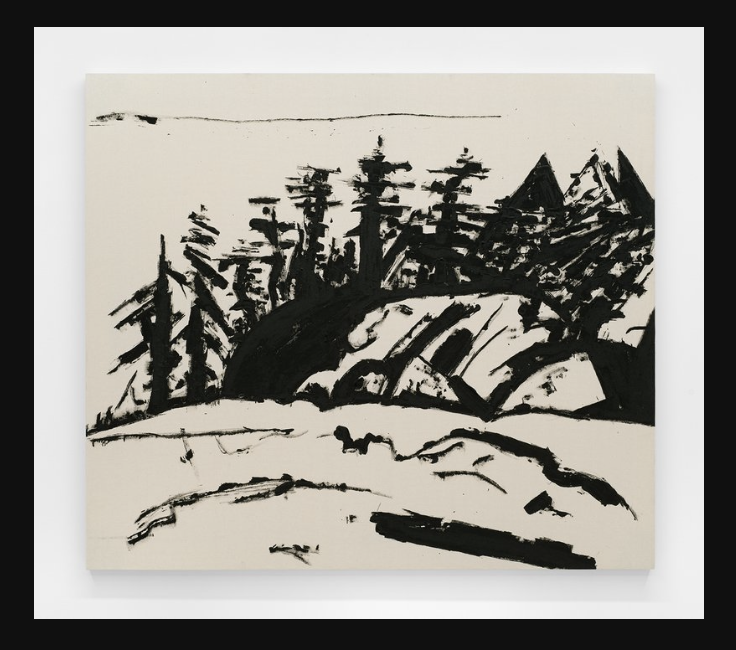
GERALD FERGUSON, ‘Trees and Rock’, 2008.
enamel on canvas / 48 x 55 in.
that’s a lot larger than the work might seem in this, straight-on photo.
as opposed to an installation shot, anchored by a gallery wall, etc.
think: 4 ft. x approx. 4-1/2 ft.
so, here’s the deal on GERALD FERGUSON,
he was many things. Above all else, he was an exploratory artist; both in thought, exploring new philosophies and theory on art, be they conceptual or minimalist / but, also an exploratory artist in terms of his own work, how he used common hardware store materials, such as ropes, rods and chains, to breach traditional boundaries. ‘Landscapes’ might be the furthest thing one might expect therefore from so entrenched a visionary and forward thinker, yet the ‘craft’ of these
landscapes, speak for themselves. all his art was the ultimate ‘stretch’ of the imagination meets future concept, so I think it’s not a stretch to associate his body of work with craft, which is very much foremost a skilled and though-out, albeit passionate endeavor.
You could rightfully say, he was to ‘craft’ a new philosophy of art-making, one which made room for the breaking down of barriers between outsider art, folk art, simple everyday objects such as hardware tools as pictorial subjects, within a minimalist design mindset that we increasingly embrace, today.
GERALD FERGUSON (b. Cincinnati, OHIO 1937 – d. 2009) was a conceptual artist and painter who lived and taught in Halifax, Nova Scotia, Canada.
“In the late 1960s, Cincinnati-born Gerald Ferguson traded in New York’s conceptual art scene for the chance to transform a provincial art college in Nova Scotia, (Canada). For Ferguson, who was in the same crowd as Lawrence Weiner, Dan Graham, and June Leaf . . . it wasn’t an easy decision to forgo the sophistication of Manhattan for a remote, impoverished navy port that valued hardiness and results over ideas; but he believed that the gallery system was starting to subsume the conceptual art movement by covertly supporting the things that he rejected – fame, excess, privilege, war. (and, probably the pressure to make salable ‘product’). Over the next decades, Ferguson worked to turn NSCAD (Nova Scotia College of Art and Design) into a conceptual hub importing visiting artists such as Gerhard Richter, Sol Lewitt, Eric Fischl, and Vito Acconci.
“Over his almost forty-year career, Ferguson wrestled with two constants. The first was a relentless battle with depression. The second was his art practice, which consisted of conceptual works and frottage paintings . . . In his frottage paintings, he treated folk and decorative art elements with a post-minimalist approach, rubbing black house paint over canvas purchased at the local sail-making shop. repeating patterns of mostly quotidian objects such as Victorian fireplace panels, chains, ropes, and rods, which leave the viewer with a sense of hard-earned humanity.
“The landscapes presented here, Ferguson’s last series of paintings, differ significantly from his past work. After breaking his arm in a car accident in 2008, Ferguson found himself unable to move his usual ropes, rods, and chains . . . Unwilling to disrupt his studio practice he returned to the paintings that inspired him as a young man . . Drawing on his prodigious knowledge of art history, and using a cheap hardware store 2.5” roller, Ferguson painted directly on raw canvas with his good arm, synthesizing elements from Cezanne through the third and fourth string landscapes that form the bulwark of American art in the first half of the 20th century to Hartley.He even let himself do a variation on plein-air painting by driving around the back roads of Nova Scotia, a diet Coke in the cup holder, a cigarette in the ash tray, fabricating sketches through his car window and a modernist American lens. Although resoundingly irascible, Ferguson was delighted to find this unexpected new studio process was marked by the presence of joy. The results in his words: ‘Dangerously close to real painting.'”
~from the wonderful press release essay by: LAURA MacDONALD
see: the press release in full / CANADA – ‘Last Landscapes’
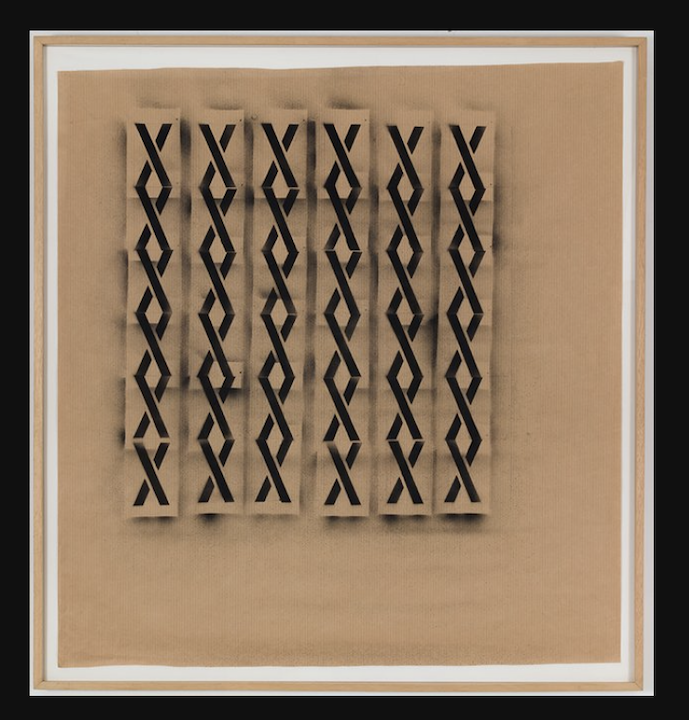
GERALD FERGUSON, ‘Untitled X’, 1968.
enamel on brown paper / 40 x 37 in.
that’s also larger than it appears . . being, approx: 3-1/3 ft. x 3 ft.
1968: he was so ahead of his time,
& really – where is the rest of that gang now. this work just keeps on, keeping on, right on point, 50 years later. it must have been so wild, and off-the-grid, back in 1968. the art world probably didn’t what to think, if they didn’t just outright ignore him /
at that time, everybody was buying Andy Warhol, weren’t they ?
no wonder he left. this is such a major, major piece of American art history.
it’s like Ruth Asawa, is all I can say /
I remember seeing this piece in an early group show at Canada, though nobody can remember exactly which one. it had a profound, validating impact on me: stencils, cut paper. common, freely available (at least back then) brown grocery wrapping paper. (you can get it for free now, in Prime Amazon boxes.) minimalist colorways, minimalist attitude, but all soul. sustainable, could be spontaneous, with a heady folk art nod, an American quilt history nod. antique woven ribbon nod. all about hardware store – arts & crafts / DIY.
in other words: AMERICANA / CRAFT TO THE MAX.
and, I’m pretty sure – I wasn’t the only one, who was hit so hard.
one can only imagine, all the ‘old stock’ hardware stores & old textile purveyors of woven ribbons, and other miscellaneous ‘notions’, including hand-woven, or early machine-made fluttering finery, such as fine white lace, and collars. the old dark wooden display cases, and old creaking wooden floors, and probably rolls upon rolls of brown wrapping paper, that Gerald Ferguson must have strolled amidst. the old tools, and brass stencils, and even the stenciled signs – that, for sure abounded in an old trading port like Nova Scotia. Downtown NYC used to be like that – all along Broadway, from Houston to Canal St., up until the late 90s, when they all got priced out, who knows where all that historic inventory ended up. real pearl shell buttons, yards and yards of woven, ribbon rolled onto paper display discs. some of it felt pioneer, it was such ‘old stock’ / straight out of Little House on the Prairie.
CRAFT. TOOLS, SKILLS. MAKING THINGS, DIY . . AMERICANA.
maybe you bought the fancy imported fabric / but, you sewed the dresses yourself.
ps: in my notes from Luke Murphy, who studied with Gerald, and curated this show:
“He was quick with biting comments and the problem was that, when it came to art and painting, the bastard was almost always right. He had such a fine and deep sense for authenticity in terms of work that nothing really got past him. I think that’s why he was also such a valued art picker for many collectors. (!!)
At one point he donated more than 500 duck decoys to the AGNS / Art Gallery Nova Scotia.”
I knew it / of course . . . !!!!!
CRAFT BABY, all the way home.
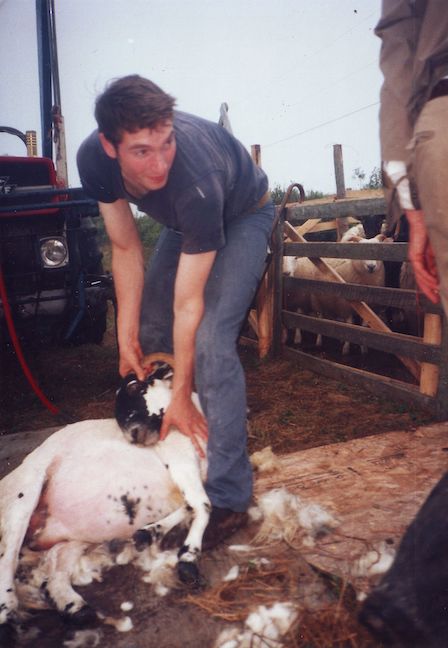
LUKE MURPHY, sometime in the mid 1980s, shearing sheep / just a few years before starting studies at NSCAD / Nova Scotia College of Art & Design, in Halifax where he studied with Gerald Ferguson, “mostly from 1987 – 1991 / then we shared a studio, and then we were friends.”
VINTAGE PHOTO COURTESY: LUKE MURPHY
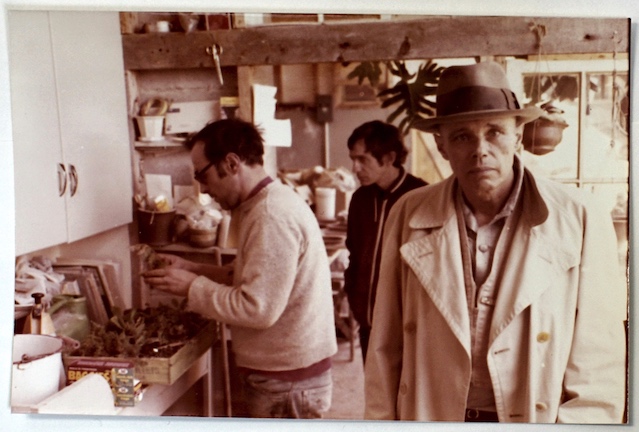
GERALD FERGUSON (L), and JOSEPH BEUYS (R), in Peggy’s Cove, Nova Scotia.
VINTAGE PHOTO COURTESY: LUKE MURPHY
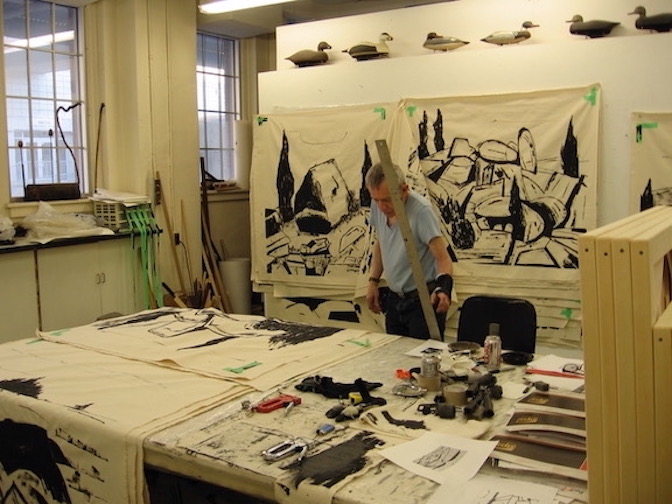
GERALD FERGUSON in his studio, Halifax, Nova Scotia / looks like it’s 2008, and that’s one of his later landscapes – on the wall behind him.
note: the vintage, and/or antique . . hand-carved & hand-painted duck decoys, arranged along the top of the back wall, on a recessed shelf.
his work may have been cutting-edge conceptual, but his ‘eye’, and ‘heart’, were all fine-tuned by . . . CRAFT. CRAFTMANSHIP. and the history, of . .
VINTAGE PHOTO COURTESY: LUKE MURPHY
